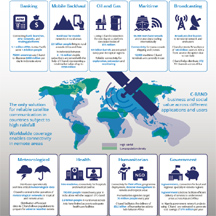The bedrock of the recommendations posited by many consulting companies involved in radio spectrum management is the cost-benefit analysis. The principal of such an analysis is quite straightforward - you calculate the cost of doing something and then evaluate the benefits of the same thing and compare one with the other. If the benefits outweight the costs, then it should be worth doing. If the costs outweigh the benefits then it is not worth doing.
 But many such analyses are incomplete. As an example, consider the case of building a new motorway over some existing farmland. A typical analysis would look at the costs in terms of the need to find alternative employment for the farmers whose land will be compulsorily purchased to turn into the motorway. The benefits would be calculated to drivers, whose journeys would be shortened and therefore who would save time and money (for fuel). This is not the whole picture: it misses a whole set of costs and a whole set of benefits. It does not take into account the cost of building the motorway, and it fails to consider the benefits being generated from the farmland (e.g. the value of the business being conducted by the farmers). The table below illustrates what a full analysis might look like.
But many such analyses are incomplete. As an example, consider the case of building a new motorway over some existing farmland. A typical analysis would look at the costs in terms of the need to find alternative employment for the farmers whose land will be compulsorily purchased to turn into the motorway. The benefits would be calculated to drivers, whose journeys would be shortened and therefore who would save time and money (for fuel). This is not the whole picture: it misses a whole set of costs and a whole set of benefits. It does not take into account the cost of building the motorway, and it fails to consider the benefits being generated from the farmland (e.g. the value of the business being conducted by the farmers). The table below illustrates what a full analysis might look like.
It might also be informative to consider other ways that the same benefits might be delivered, for example by re-engineering existing roads, or by using more fuel efficient cars.
None of this is rocket science and even those studying economics at school ought to be able to identify all of the costs and benefits. It is surprising, therefore, that some otherwise well-respected economists continue to write reports that miss out parts of the analysis. Plum Consulting (no stranger to Wireless Waffle) have recently published a report entitled 'Use of C-Band for mobile broadband in Hungary, Italy, Sweden and the UK'. In it they conduct a cost-benefit analysis of migrating existing spectrum users out of the C-Band (3400 - 4200 MHz) and using it for mobile broadband services. But as with the example above, they fail to consider all the cost and all the benefits. They consider the costs to existing users, and benefits to the new users, but not the benefits to existing users or costs to the new users. The table below summarises their analysis.
In addition to missing a large chunk of the necessary analysis, they also do not assess alternative methods to achieve the same outcome. For example, no consideration is given to whether the improved spectrum efficiency of 5G networks (which will presumably have started being rolled-out in the timescales considered in the report) would be more cost effective for the mobile broadband operators than using older technology in a new band. The fact that the costs to the mobile operators are not evaluated serves to hide alternative solutions such as this.
 Of course the report has been paid for by Ericsson, Huawei and Qualcomm and so it would be expected that the results would show in favour of the mobile industry, and so missing out various parts of the analysis which might make the results less favourable is perhaps no surprise. It is also the case that, for example, evaluating the value of the spectrum to the existing users is a complicated task due to the very wide range of types of users that would have to be considered, from the oil and gas industry to banks, and from broadcasting to humanitarian relief. The Satellite Spectrum Initiative have published a helpful factsheet which identifies and, to some extent, quantifies, the value of the use of C-band to various users. To actually value the C-band properly is a big task which it seems that even the satellite operators who stand to lose most if the spectrum is re-farmed for mobile services, are unwilling to cough up the funds needed to put a figure on it.
Of course the report has been paid for by Ericsson, Huawei and Qualcomm and so it would be expected that the results would show in favour of the mobile industry, and so missing out various parts of the analysis which might make the results less favourable is perhaps no surprise. It is also the case that, for example, evaluating the value of the spectrum to the existing users is a complicated task due to the very wide range of types of users that would have to be considered, from the oil and gas industry to banks, and from broadcasting to humanitarian relief. The Satellite Spectrum Initiative have published a helpful factsheet which identifies and, to some extent, quantifies, the value of the use of C-band to various users. To actually value the C-band properly is a big task which it seems that even the satellite operators who stand to lose most if the spectrum is re-farmed for mobile services, are unwilling to cough up the funds needed to put a figure on it.
 Until such time as someone does pay to do the job properly, it seems that all discussions on the value of C-band spectrum to satellite operators or to mobile operators will be conducted without all the facts being on the table. With C-band being a hotly contended issue at the forthcoming World Radiocommunication Conference (WRC) (which will take place at the ITU in November in Geneva) any decisions taken will be rather uninformed. Such important decisions, with billions of pounds of mobile and satellite money involved, should not be taken so lightly. Maybe those users who rely on C-band for their businesses today could club together and raise enough money for decent economics experts to actually work out a realistic value of today's C-band use, and equally the mobile industry could do a full analysis of the costs and benefits of the use of the band, and of other alternatives so that all concerned could be comfortable that they are taking any decisions on a realistic basis.
Until such time as someone does pay to do the job properly, it seems that all discussions on the value of C-band spectrum to satellite operators or to mobile operators will be conducted without all the facts being on the table. With C-band being a hotly contended issue at the forthcoming World Radiocommunication Conference (WRC) (which will take place at the ITU in November in Geneva) any decisions taken will be rather uninformed. Such important decisions, with billions of pounds of mobile and satellite money involved, should not be taken so lightly. Maybe those users who rely on C-band for their businesses today could club together and raise enough money for decent economics experts to actually work out a realistic value of today's C-band use, and equally the mobile industry could do a full analysis of the costs and benefits of the use of the band, and of other alternatives so that all concerned could be comfortable that they are taking any decisions on a realistic basis.
 But many such analyses are incomplete. As an example, consider the case of building a new motorway over some existing farmland. A typical analysis would look at the costs in terms of the need to find alternative employment for the farmers whose land will be compulsorily purchased to turn into the motorway. The benefits would be calculated to drivers, whose journeys would be shortened and therefore who would save time and money (for fuel). This is not the whole picture: it misses a whole set of costs and a whole set of benefits. It does not take into account the cost of building the motorway, and it fails to consider the benefits being generated from the farmland (e.g. the value of the business being conducted by the farmers). The table below illustrates what a full analysis might look like.
But many such analyses are incomplete. As an example, consider the case of building a new motorway over some existing farmland. A typical analysis would look at the costs in terms of the need to find alternative employment for the farmers whose land will be compulsorily purchased to turn into the motorway. The benefits would be calculated to drivers, whose journeys would be shortened and therefore who would save time and money (for fuel). This is not the whole picture: it misses a whole set of costs and a whole set of benefits. It does not take into account the cost of building the motorway, and it fails to consider the benefits being generated from the farmland (e.g. the value of the business being conducted by the farmers). The table below illustrates what a full analysis might look like.| Costs | Benefits | |
|---|---|---|
| Farmers | Moving farm to new location or finding alternative employment | Revenue generated from existing farming business |
| Drivers | Building a new motorway and modifications to existing roads | Shorter and faster journeys, savings in fuel consumption |
It might also be informative to consider other ways that the same benefits might be delivered, for example by re-engineering existing roads, or by using more fuel efficient cars.
None of this is rocket science and even those studying economics at school ought to be able to identify all of the costs and benefits. It is surprising, therefore, that some otherwise well-respected economists continue to write reports that miss out parts of the analysis. Plum Consulting (no stranger to Wireless Waffle) have recently published a report entitled 'Use of C-Band for mobile broadband in Hungary, Italy, Sweden and the UK'. In it they conduct a cost-benefit analysis of migrating existing spectrum users out of the C-Band (3400 - 4200 MHz) and using it for mobile broadband services. But as with the example above, they fail to consider all the cost and all the benefits. They consider the costs to existing users, and benefits to the new users, but not the benefits to existing users or costs to the new users. The table below summarises their analysis.
| Costs | Benefits | |
|---|---|---|
| Existing Users (Satellite and Fixed Links) | Modifying equipment to allow access by mobile or using alternative frequencies. | Not considered |
| New Users (Mobile Broadband) | Not considered | Higher speed connections in hotspot areas. |
In addition to missing a large chunk of the necessary analysis, they also do not assess alternative methods to achieve the same outcome. For example, no consideration is given to whether the improved spectrum efficiency of 5G networks (which will presumably have started being rolled-out in the timescales considered in the report) would be more cost effective for the mobile broadband operators than using older technology in a new band. The fact that the costs to the mobile operators are not evaluated serves to hide alternative solutions such as this.
 Of course the report has been paid for by Ericsson, Huawei and Qualcomm and so it would be expected that the results would show in favour of the mobile industry, and so missing out various parts of the analysis which might make the results less favourable is perhaps no surprise. It is also the case that, for example, evaluating the value of the spectrum to the existing users is a complicated task due to the very wide range of types of users that would have to be considered, from the oil and gas industry to banks, and from broadcasting to humanitarian relief. The Satellite Spectrum Initiative have published a helpful factsheet which identifies and, to some extent, quantifies, the value of the use of C-band to various users. To actually value the C-band properly is a big task which it seems that even the satellite operators who stand to lose most if the spectrum is re-farmed for mobile services, are unwilling to cough up the funds needed to put a figure on it.
Of course the report has been paid for by Ericsson, Huawei and Qualcomm and so it would be expected that the results would show in favour of the mobile industry, and so missing out various parts of the analysis which might make the results less favourable is perhaps no surprise. It is also the case that, for example, evaluating the value of the spectrum to the existing users is a complicated task due to the very wide range of types of users that would have to be considered, from the oil and gas industry to banks, and from broadcasting to humanitarian relief. The Satellite Spectrum Initiative have published a helpful factsheet which identifies and, to some extent, quantifies, the value of the use of C-band to various users. To actually value the C-band properly is a big task which it seems that even the satellite operators who stand to lose most if the spectrum is re-farmed for mobile services, are unwilling to cough up the funds needed to put a figure on it.  Until such time as someone does pay to do the job properly, it seems that all discussions on the value of C-band spectrum to satellite operators or to mobile operators will be conducted without all the facts being on the table. With C-band being a hotly contended issue at the forthcoming World Radiocommunication Conference (WRC) (which will take place at the ITU in November in Geneva) any decisions taken will be rather uninformed. Such important decisions, with billions of pounds of mobile and satellite money involved, should not be taken so lightly. Maybe those users who rely on C-band for their businesses today could club together and raise enough money for decent economics experts to actually work out a realistic value of today's C-band use, and equally the mobile industry could do a full analysis of the costs and benefits of the use of the band, and of other alternatives so that all concerned could be comfortable that they are taking any decisions on a realistic basis.
Until such time as someone does pay to do the job properly, it seems that all discussions on the value of C-band spectrum to satellite operators or to mobile operators will be conducted without all the facts being on the table. With C-band being a hotly contended issue at the forthcoming World Radiocommunication Conference (WRC) (which will take place at the ITU in November in Geneva) any decisions taken will be rather uninformed. Such important decisions, with billions of pounds of mobile and satellite money involved, should not be taken so lightly. Maybe those users who rely on C-band for their businesses today could club together and raise enough money for decent economics experts to actually work out a realistic value of today's C-band use, and equally the mobile industry could do a full analysis of the costs and benefits of the use of the band, and of other alternatives so that all concerned could be comfortable that they are taking any decisions on a realistic basis.add comment
( 885 views )
| permalink
| 



 ( 3.1 / 490 )
( 3.1 / 490 )




 ( 3.1 / 490 )
( 3.1 / 490 )

